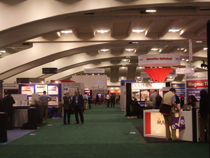 So now that there are a couple of weeks to allow a bit of introspection (also known as reading everyone else’s blogs) what were the big themes?
So now that there are a couple of weeks to allow a bit of introspection (also known as reading everyone else’s blogs) what were the big themes?
On the technical side I think it is the fifth, or whatever, year that this is the year of ESL at DAC. ESL has been the Gallium Arsenide of EDA for a long time, just about mature enough to finally really take off "real soon now". But this time it feels like it might be starting to be real. There are several established players in ESL synthesis aka HLS (Mentor, Forte, Cadence, Synfora, Bluespec, AutoESL) and one, Calypto, in formal verification. I think Calypto are actually very well-positioned in the market since there’s only one of them right now, and because formal verification is CPU intensive that drives license demand naturally as the tool is adopted and used on larger designs. There are clearly too many players in the synthesis space for them all to be successful, and several of them have been around so long with so many rounds of investment that it is hard to see how they could be successes for their investors whatever happens.
There definitely seemed to be a feeling that handoff of designs was moving up to the level of C (or C++ or SystemC) from RTL, although the precise way this would happen is still murky. And the software ties in there, maybe, but most people in EDA don’t really understand the software component of systems.
Another technical theme was that there are a lot of companies attacking Cadence’s Virtuoso walled-city for analog design. Whether they’ll succeed in bringing down the walls or once again blunt their lances on the brickwork remains to be seen. Synopsys now has a serious entry in the space, Springsoft continues to be strong especially in Taiwan, Ciranova is trying to break open the Skill portcullis, and lots of other companies filling in various analog niches.
Lurking around under the surface was multicore, especially in the nVidia keynote. I’m less bullish on the notion that Amdhahl’s law is repealed than William Daily was, and there are simply enormous amounts of legacy code around. But electronic systems have an enormous software component, and it is becoming a harder problem than the chip design in many cases.
At the risk of sounding self-serving I think this was also the year of the blogger. I was described on the blogging panel as the “Lance Armstrong of blogging” by Sean Murphy, which I guess means I’m an old guy who came third, but I think it was meant as a compliment. For the Denali "next EDA blogger" competition, Karen Bartleson of Synopsys won. I guess she’s the Alberto Contador of bloggers.
Seriously though, for analysis of the industry I think it is clear that the bloggers are doing a better job than anyone else. True, we are not trained as professional journalists but I’m constantly impressed by the standard of writing and the deep technical knowledge of some of the bloggers. It’s not clear how it will all play out, in particular how useful many of the corporate blogs will turn out to be. They tend to stick too close to the party line in most cases to be all that interesting, and avoid controversial topics. I’d be interested to know how widely read they are.
And on a personal note, it’s my Dad’s birthday. Hi Dad.
